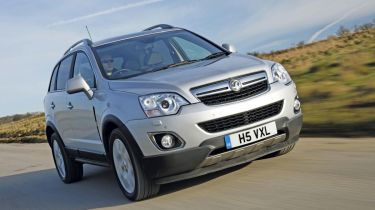Vauxhall Antara
Vauxhall's high-riding 4x4 has been given a complete makeover - but does a new engine and visual changes make it a class contender?
While the fresh-faced Antara is much better than before, the crossover market is already full of far more rounded and desirable models. The new diesel engine is a strong performer, but the rest of the car is starting to show its age – from the cramped boot space to the jittery ride and cheap-feeling materials. It can’t match newer contenders, such as the Hyundai ix35, and feels more like an old-fashioned SUV than a versatile crossover. The 4x4 version comes with more equipment, and is capable off-road, but it’s more expensive.
In Issue 1,152, we revealed that an all-new baby SUV from Vauxhall is well on its way to production. But until it arrives, the company’s hopes in the crossover class rest with this – the heavily revised Antara.
The car’s styling has been left largely untouched, which is no bad thing. Yet the handsome looks have been brought up to date with a new chrome family grille and fresh foglamp surrounds at the front, plus tweaked light clusters at the back.
Most of the changes have taken place under the chunky bodywork. Buyers get only the one engine option: a punchy new 2.2-litre diesel, available with 161bhp or 181bhp. It’s mated to an all-new six-speed manual transmission, and both variants are cleaner and more powerful than the 2.0-litre they replace. Our 161bhp car trails the best in class on emissions, though, putting out 167g/km.
The Antara pulls strongly above 2,000rpm, and despite being a bit gruff when getting up to speed, at motorway cruising pace, the engine settles down to a comfortable and quiet sound. Wind noise is the only thing to disturb the peace and quiet of the cabin – which incidentally has been given the least attention in the revamp.
It does get extra chrome-effect and silver trim, though, plus an electronic handbrake is now fitted as standard. This frees up space for a clever dual-layered storage bin in front of the armrest. Even so, the cabin struggles to impress – the layout is dated, while the indicator stalks and oversized steering wheel use cheap, scratchy plastics that feel fragile.
We drove both the two and four-wheel-drive versions, although there was little difference in terms of performance. If anything, the lighter front-driven model feels more nimble and quicker to respond to changes in direction. It’s also quite a bit cheaper to buy and run, with this Exclusiv version costing £19,995 – undercutting the Ford Kuga and VW Tiguan.
However, both variants are scuppered by the ride. The chassis has been retuned to improve comfort, but the Antara still crashes over even the smallest bumps and potholes. This harshness doesn’t increase handling prowess, either – body control is poor, a problem exacerbated by vague and inconsistent steering. Ultimately, the new Antara doesn’t do enough to stand out in an increasingly tough sector.
Rival: Skoda Yeti
For the same price as the Vauxhall, you can get a 138bhp TDI Yeti with 4WD. It’s just as fast, but much more refined, and has a larger boot and more standard kit.



